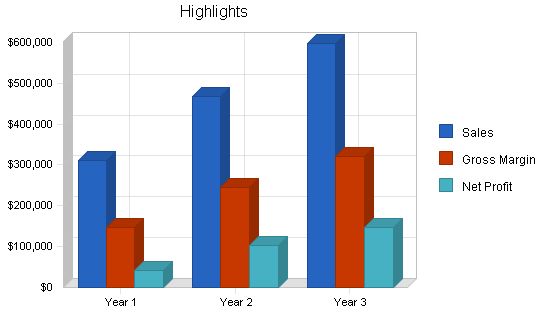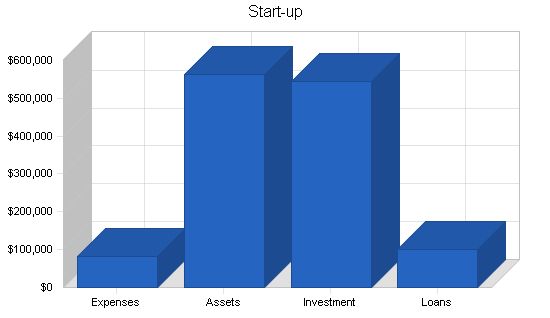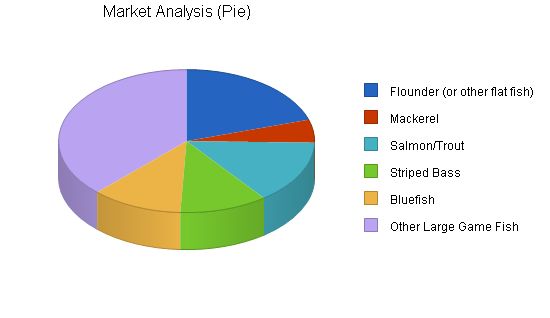Fishing Equipment Business Plan
Seacliff Products (Seacliff) is an innovative company that has developed a patented fishing hook. Seacliff has initially created a do-it-yourself-kit for sale while they find a suitable business partner to license the product. Seacliff has forecasted high sales for year one and a significant increase for year two.
Seacliff has developed the Supreme hook, a live bait holder that increases fish hook up. This increase in fish hookups enhances the user’s fishing experience.
The Business Model
Seacliff will utilize a laser-focused business model that focuses on their core competencies while outsourcing non-value adding activities. Seacliff is a design company and will concentrate on designing useful products. They will seek a strategic partner to handle production, marketing, and distribution. Outsourcing non-essential activities allows Seacliff to generate substantial profits without the burdens of marketing, manufacturing, and distribution. Through licensing, Seacliff grants the right to produce the Supreme hook while earning steady revenue without the capital costs. Seacliff enjoys high profits and is supported by a professional marketing department, as well as an established distribution and production system. Seacliff is currently seeking a strategic partner and expects to enter into negotiations soon.
The Market
The fishing market for the Supreme hook is large and valued at $300 million. In the U.S.A., there are over 39.1 million anglers who have fished over 618 million days and taken 807 million trips. Furthermore, this industry has experienced rapid growth, with the number of anglers increasing at more than twice the rate of the U.S. population from 1955-1996.
Management
The foundation of the business model is to focus on what you are good at. Seacliff embodies this principle by concentrating on design. The owner (name omitted) holds a JD/MBA from Willamette University, which provided valuable insight into business development, as well as knowledge of licenses and patents. After graduate school, he became a fly fishing guide in Oregon and developed a passion for fishing. He returned to school to obtain a Masters in Engineering to pursue the design and development of fishing-related products. Towards the end of his graduate degree, he created the Supreme hook. With his JD/MBA background, he founded his own company and sought a manufacturer to license his soon-to-be-patented product.
Seacliff is an exciting company that avoids the need for extensive start-up capital by licensing their patented product. This allows Seacliff to focus on value-added activities such as future designs. Profitability will be achieved by month one.

1.1 Mission:
The mission of Seacliff is to maximize the profit potential of its patented fish hook invention (the Supreme) through licensing and other means, and to develop additional innovative products for the fishing gear market.
1.2 Keys to Success:
The keys to success in maximizing profits from licensing this patent are:
– Separate the manufacturing of the Supreme from its marketing.
The keys to success in profiting from the patent in make-it-yourself kit form are:
– Recognize the narrower market for the kit.
1.3 Objectives:
The main objectives are:
– Locate a suitable manufacturer willing to produce the patented Supreme hook at a reasonable price on an exclusive basis. This would cause the Supreme to sell for under 150% of a normal hook’s retail price.
Seacliff is a start-up limited-liability corporation based in Oregon.
2.1 Company Ownership:
The company is 80% owned by the founder and inventor of the Supreme, with the remaining shares owned by six individual investors.
2.2 Start-up Summary:
To secure the necessary start-up funds, external financing must be obtained. The start-up expenses are itemized below:
– Various expenses for legal, travel, salaries, and design costs
– Start-up inventory: Cash needed to purchase materials included in the kit before sales begin in January
– Long-term assets: Purchase price of Patent Number 6,038,806 and minor office equipment
– Start-up funding: Heavy investment by the inventor/founder and additional investment by six individual investors. A barter agreement has been made for essential peg and graphic illustration work, and a final sum is expected to be raised from the sale of stock to individual investors between mid-October and the end of December.

Start-up Requirements:
– Legal: $6,000
– Printing/Reproduction: $3,000
– Salaries: $7,000
– Prototype: $7,500
– Utilities: $2,000
– Graphic Design: $29,500
– Misc expenses, Travel, Enter.: $7,900
– Tooling: $20,350
– Other: $0
– Total Start-up Expenses: $83,250
Start-up Assets:
– Cash Required: $20,000
– Start-up Inventory: $58,530
– Other Current Assets: $0
– Long-term Assets: $483,425
– Total Assets: $561,955
Total Requirements: $645,205
Start-up Funding:
– Start-up Expenses to Fund: $83,250
– Start-up Assets to Fund: $561,955
– Total Funding Required: $645,205
Assets:
– Non-cash Assets from Start-up: $541,955
– Cash Requirements from Start-up: $20,000
– Additional Cash Raised: $0
– Cash Balance on Starting Date: $20,000
– Total Assets: $561,955
Liabilities and Capital:
– Liabilities:
– Current Borrowing: $0
– Long-term Liabilities: $100,000
– Accounts Payable (Outstanding Bills): $0
– Other Current Liabilities (interest-free): $0
– Total Liabilities: $100,000
Capital:
– Planned Investment:
– Founder/President: $482,000
– Individual Investors (6): $26,000
– Design & Consultant Barter Stock: $27,000
– Other: $10,205
– Additional Investment Requirement: $0
– Total Planned Investment: $545,205
– Loss at Start-up (Start-up Expenses): ($83,250)
– Total Capital: $461,955
Total Capital and Liabilities: $561,955
Total Funding: $645,205
Company Locations and Facilities:
The company is located in Florence, Oregon, where there is adequate storage and office space available.
Products:
There are two marketable products from the same patent. One will result in royalties when licensed to a fishing gear marketing company. The other is a kit for fishing enthusiasts to make the Supreme before mass distribution.
Product Description:
The Supreme is a standard hook with a specially-designed bait holder that improves fish attraction and hook-ups. It can be used with shrimp or crab bait and dead bait trolling.
Benefits of the Invention:
– Increased hook-ups by permitting full-hook exposure in a disguised manner.
– Faster rigging of bait fish without keeping the bait fish out of the water for long.
– Barb attaches to the bait fish under the scales and skin, prolonging the life of the bait fish.
– Keeping the bait fish on the hook is less of a problem because of the holding barb.
– Location of the hook on the bait fish increases chances of a hook-up.
– Several body locations of the bait fish can be used with the patented hook.
– Excellent application in freshwater or saltwater fishing with live shrimp or crab.
– Fun and easy to use.
Do-it-yourself Kits:
The Supreme can be marketed in kit form. The kit contains barbs, crimping tool, and all necessary apparatus for attaching the barb to most commercial hooks with epoxy.
Competitive Comparison:
This product is unique. However, there are other do-it-yourself kits in the fishing industry. Please refer to Section 5.2.2, Pricing Strategy, for more information.
Sales Literature:
Excellent graphics have been prepared to demonstrate the features of the hook. They will be incorporated into a brochure that doubles as a mailer, with contact information and website address. This project is currently underway.
Sourcing:
Sourcing of raw materials to produce the kits is not difficult, as there are multiple suppliers for each essential part. Local suppliers are expected as sales of the kits increase.
Future Products:
Future products include a rod and reel action holder, non-toxic dead-bait trolling stabilizer, and an adapter rod holder for bait jiggers.
Market Analysis Summary:
The market for the Supreme hook is large, with potential in the fishing gear industry. The unique look and user-friendly features of the Supreme can capture market share. The Supreme has the potential to capture 10% of the hook market, resulting in significant royalties for the patent holder. The do-it-yourself kit appeals to a narrower segment of saltwater fishermen, with estimated sales of 25,000 kits over three years.
Market Segmentation:
The focus is on sales of the do-it-yourself kits until a license agreement is reached with a fishing gear company. The target market is saltwater fishermen who go after the 20 species of large game fish. These fishermen are passionate, serious about the sport, have boats, and read fishing magazines. They have a higher income and are willing to invest in specialized fishing equipment.
Appendix:
Appendix information was not available for this sample plan.

Market Analysis:
Potential Customers: Growth Year 1, Year 2, Year 3, Year 4, Year 5, CAGR
Flounder (or other flat fish): 1%, 2,626, 2,652, 2,679, 2,706, 2,733, 1.00%
Mackerel: 1%, 683, 690, 697, 704, 711, 1.01%
Salmon/Trout: 1%, 1,877, 1,896, 1,915, 1,934, 1,953, 1.00%
Striped Bass: 1%, 1,443, 1,457, 1,472, 1,487, 1,502, 1.01%
Bluefish: 1%, 1,499, 1,514, 1,529, 1,544, 1,559, 0.99%
Other Large Game Fish: 1%, 4,928, 4,977, 5,027, 5,077, 5,128, 1.00%
Total: 1.00%, 13,056, 13,186, 13,319, 13,452, 13,586, 1.00%
4.2 Target Market Segment Strategy:
The target market strategy is to focus on large saltwater game fish anglers, specifically striped bass, bluefish, and other large game fish. Of the total saltwater fishermen, 7,180 are located in eight coastal states.
4.2.1 Market Trends:
Fishing is growing in popularity, with the number of anglers increasing at twice the rate of the U.S. population. Americans spend $38 billion annually on fishing, with 51% on fishing equipment and 28% on fishing tackle.
4.2.2 Market Growth:
The number of saltwater fishermen increased by six percent between 1991-1996, while freshwater fishermen declined by four percent. Expenditures on fishing increased by 37% and the number of days spent fishing increased by 22%.
4.2.3 Market Needs:
The patented Supreme hook offers convenience, speed, improved performance, and enjoyment for anglers. See Chapter 3.1 for details and illustrations.
4.3 Industry Analysis:
The fishing gear industry has undergone consolidation, with small manufacturers being acquired by larger competitors. Mass market retailers and catalogues sell 75% of fishing tackle.
4.3.1 Distribution Patterns:
The majority of tackle is bought through wholesalers and direct from manufacturers. Large retailers prefer to buy directly from manufacturers for better margins.
4.3.2 Main Competitors:
The Supreme competes with traditional methods of hooking bait. It offers unique features and there is no other product that provides the same benefits.
4.3.3 Industry Participants:
The fishing industry has 450 companies involved in various aspects of fishing. Large retailers and boat manufacturers are also part of the industry.
Strategy and Implementation Summary:
The initial focus will be on marketing the Supreme through magazines and wholesalers to reach saltwater fishermen. A suitable licensee marketing company will be pursued for mass marketing.
5.1 Competitive Edge:
The Supreme’s stem-hook system is patented and not available from any other supplier. Its unique features make it an ideal USP for marketing.
5.2 Marketing Strategy:
The positive reactions from industry participants have been promising. An organized approach will be followed to locate a suitable licensee marketing company. The ASA Trade Show will also be utilized to attract interest.
5.2.1 Distribution Strategy:
Nautical Marketing will represent the do-it-yourself kits to wholesalers, focusing on the eight coastal states with the highest number of saltwater anglers. Pricing has been arranged to ensure generous margins for wholesalers and retailers.
5.2.2 Positioning Statement:
The Supreme is best marketed to saltwater fishermen who are enthusiastic about larger-game fish. Word-of-mouth and targeted advertising will be utilized to reach this niche market.
5.2.3 Pricing Strategy:
Pricing for the Supreme kit will be determined based on the uniqueness of the product and market demand. Examples of non-competing kits show considerable pricing for fishing gear kits. The pricing structure follows a standard retail cost model.
(Delivery of the text has been minimized by eliminating repetitive phrases and redundant information.)
Hello!
I’m Andrew Brooks, a seasoned finance consultant from the USA and the mind behind phonenumber247.com.
My career is built on a foundation of helping individuals and businesses thrive financially in an ever-changing economic landscape. At phonenumber247.com, my aim is to demystify the complex world of finance, providing clear, actionable advice that can help you navigate your financial journey with confidence. Whether it’s personal finance management, investment strategies, or understanding the nuances of market dynamics, I’m here to share insights and tools that can propel you towards your financial goals.
Welcome to my digital space, where every piece of advice is a step closer to financial clarity and success!
